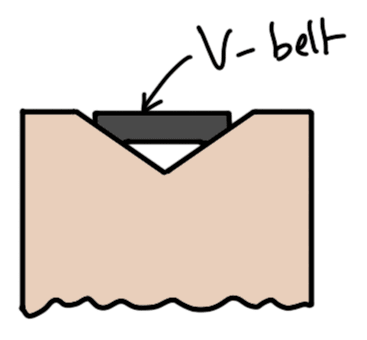The belts or ropes are used to transmit power from one shaft to another by means of pulleys that rotate at the same speed or at different speeds. The material used for belts and ropes must be strong, flexible, and durable. It must have a high coefficient of friction. Let us discuss the criteria for the Selection of a Belt Drive for any application and type of belt drive and belts.

The amount of power transmitted depends upon the following factors:
- The velocity of the belt.
- The tension under which the belt is placed on the pulleys.
- The arc of contact between the belt and the smaller pulley.
- The conditions under which the belt is used.
Additionally, it is also important to follow the below guidelines.
- The shafts should be properly in line to insure uniform tension across the belt section.
- The pulleys should not be too close together, in order that the arc of contact on the smaller pulley may be as large as possible.
- The pulleys should not be so far apart as to cause the belt to weigh heavily on the shafts, thus increasing the friction load on the bearings.
- Along the belt tends to swing from side to side, causing the belt to run out of the pulleys, which in turn develops crooked spots in the belt.
- The right side of the belt should be at the bottom so that whatever sag is present on the loose side will increase the arc of contact at the pulleys.
- In order to obtain good results with flat belts, the maximum distance between the shafts should not exceed 10 meters and the minimum should not be less than 3.5 times the diameter of the larger pulley.
Selection of a Belt Drive
Following are the various important factors upon which the selection of a belt drive depends:
- Speed of the driving and driven shafts
- Speed reduction ratio
- Power to be transmitted
- Centre distance between the shafts
- Positive drive requirements
- Shafts layout
- Space available
- Service conditions
Types of Belt Drives
The belt drives are usually classified into the following three groups:
1. Light drives:
These are used to transmit small powers at belt speeds up to about 10 m/s as in agricultural machines and small machine tools.
2. Medium drives:
These are used to transmit medium powers at belt speeds over 10m/s but up to 22 m/s, as in machine tools.
3. Heavy drives:
These are used to transmit large powers at belt speeds above 22 m/s as in compressors and generators.
Types of Belts
Though there are many types of belts used these days, the following are important from the subject point of view:
1. Flat belt
The flat belt as shown in the following figure is mostly used in factories and workshops, where a moderate amount of power is to be transmitted, from one pulley to another when the two pulleys are not more than 8 meters apart.

2. V-belt
The V-belt as shown in the following figure, is mostly used in factories and workshops, where a great amount of power is to be transmitted, from one pulley to another, when the two pulleys are very near to each other.

3. Circular belt or rope
The circular belt or rope as shown in the following figure is mostly used in factories and workshops, where a great amount of power is to be transmitted, from one pulley to another, when the two pulleys are more than 8 meters apart.

If a huge amount of power is to be transmitted, then a single belt may not be sufficient. In such a case, wide pulleys (for V-belts or circular belts) with a number of grooves are used. Then a belt in each groove is provided to transmit the required amount of power from one pulley to another.

Leave a Reply